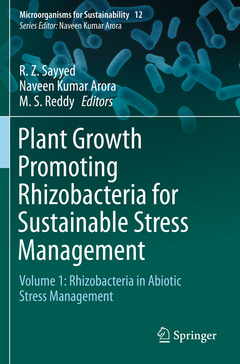Plant Growth Promoting Rhizobacteria for Sustainable Stress Management, 1st ed. 2019 Volume 1: Rhizobacteria in Abiotic Stress Management Microorganisms for Sustainability Series, Vol. 12
Coordonnateurs : Sayyed R. Z., Arora Naveen Kumar, Reddy M. S.

Riyaz Z Sayyed is an Associate Professor and Head of the Department of Microbiology, PSGVP Mandal’s Arts, Science College, Shahada, Maharashtra, India. Currently, he serves as President of the Indian Chapter of the Asian PGPR Society for Sustainable Agriculture. He has 15 years of research expertise in siderophore based PGPR and has authored 91 peer-reviewed research papers and 64 books. He is a recipient of many prestigious awards and honors from various research societies and the Government of India. In addition, he is an Associate Editor of the journal Environmental Sustainability (Springer).
Naveen Kumar Arora, a Professor at the Department of Environmental Science, Babasaheb Bhimrao Ambedkar University, Lucknow, India is a respected researcher in the field of Environmental Microbiology and Biotechnology. He has authored more than 60 articles and edited 12 books, all published by Springer. He is the Editor in Chief of the journal Environmental Sustainability published by Springer Nature. He is recipient of many prestigious awards, passionate advocate of wildlife conservation and President of the Society for Conservation of Wildlife.
Munagala S. Reddy is a Professor at the Department of Entomology & Plant Pathology at Auburn University, Auburn, USA and Founder and Chairman of the Asian PGPR Society for Sustainable Agriculture. He is a recipient of many prestigious awards from the USA, Canada, Saudi Arabia, Indonesia, Philippines, China, India, etc. and has successfully generated several millions of dollars in funding from federal, international and private agencies for his research on commercializing biofertilizers and biofungicides (PGPR). Currently, he is an entrepreneur and consultant for several national and international agencies. He has authored or co-authored over 300 publications.
Date de parution : 09-2020
Ouvrage de 362 p.
15.5x23.5 cm
Disponible chez l'éditeur (délai d'approvisionnement : 15 jours).
Prix indicatif 158,24 €
Ajouter au panierDate de parution : 09-2019
Ouvrage de 362 p.
15.5x23.5 cm
Thèmes de Plant Growth Promoting Rhizobacteria for Sustainable... :
Mots-clés :
PGPR; Biotic Stress; Plant Growth; Biocontrol; Sustainable Agriculture



